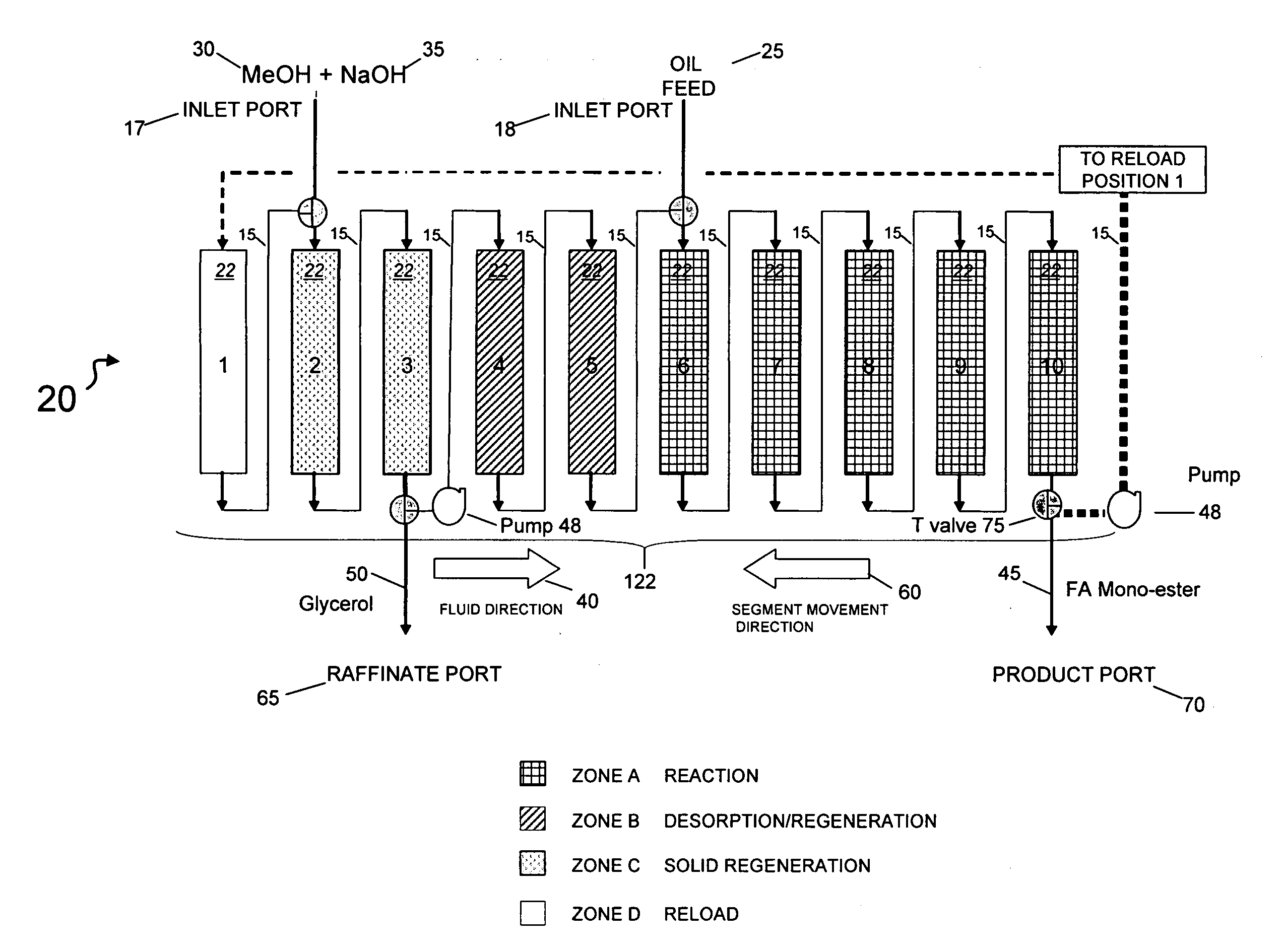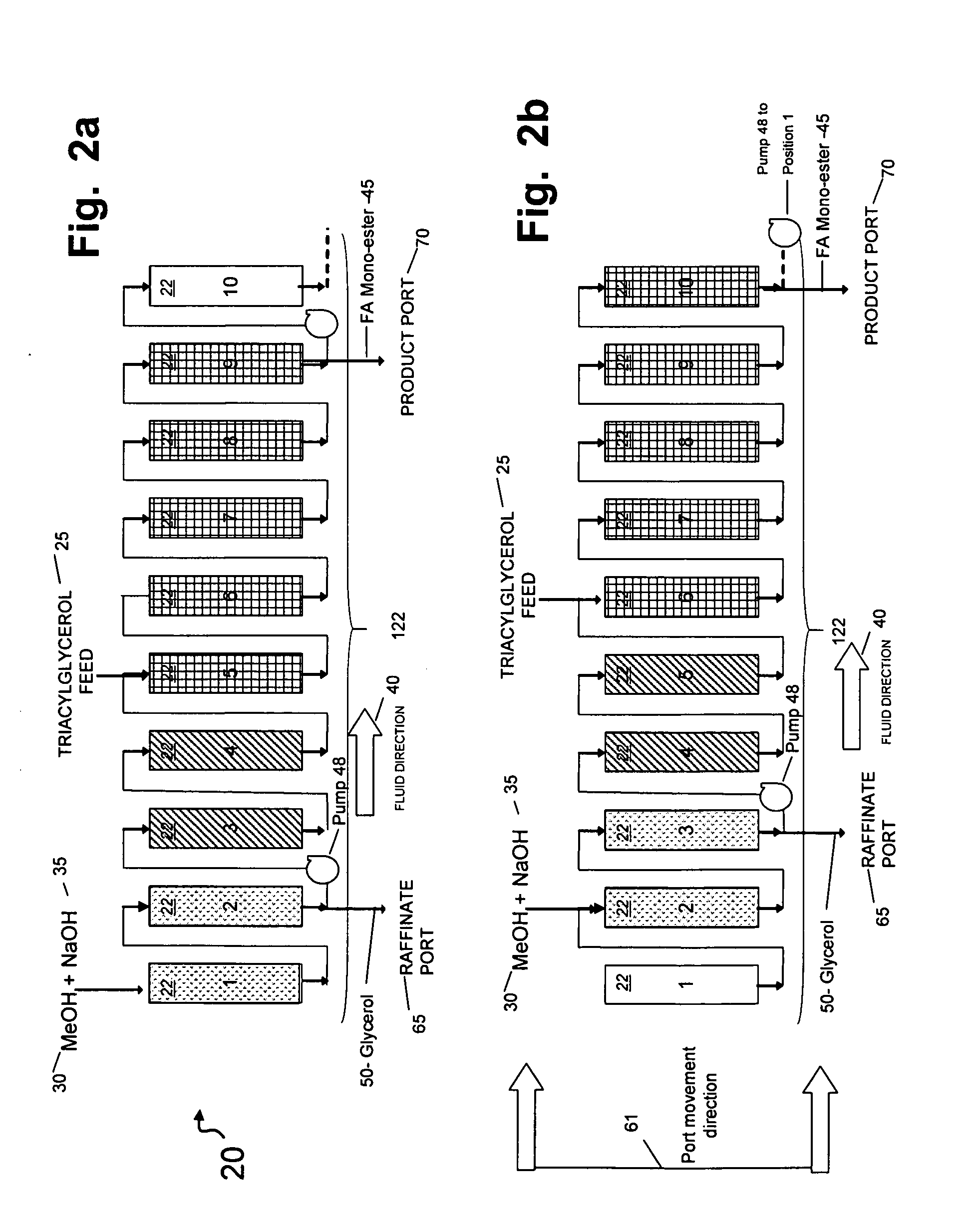Simultaneous synthesis and purification of a fatty acid monoester biodiesel fuel
a technology of biodiesel fuel and fatty acid monoesters, which is applied in the direction of catalyst activation/preparation, fatty acid chemical modification, fatty oil/fat refining, etc., can solve the problems of uneconomical efficiency, unwanted saponification of coproducts (e.g. sodium salts of fatty acids), and loss of soap resulting from synthesis
- Summary
- Abstract
- Description
- Claims
- Application Information
AI Technical Summary
Benefits of technology
Problems solved by technology
Method used
Image
Examples
example 1
[0149]In this example, the catalytic chromatographic bed comprising a strong base ion exchange resin PA308 Mitsubishi Chemical Co. (Tokyo, Japan) was configured in a 1-2-2-5 sequence in a simulated moving bed (SMB) apparatus in a temperature-controlled cabinet maintained at 55° C. At this temperature, no vapor phase was present in the apparatus. Resin was slurried in methanol and loaded into each of the ten columns containing 300 ml. Zone A was a reaction zone; Zone B was a desorption / regeneration zone; Zone C was a solid regeneration zone, and Zone D was a reload zone (FIG. 1). The SMB apparatus contained 10 columns in a circular series on a carousel, and provisions for rotating the columns in the direction opposite the flow of fluid at defined intervals, called the “Step Time”. The step time was 10 minutes. In the 1-2-2-5 sequence, the numbers refer to the quantity of columns in each zone. The initial digit (“1”) describes the quantity of columns in a reload zone (Zone D) comprisi...
example 2
[0155]The process of Example 1 was carried out substantially as in Example 1 on the same triglyceride feed using Mitsubishi PA 308 resin as a first catalyst, with changes in flow rates indicated in Table 2.
TABLE 2All values are in percentRaffi-FeedProductnateTAG ml / min.10.28wt %wt %wt %MeOH* ml / min.26.94Solids99.953.73.3Desorb ml / min.25.45Monoglyceride0.020.180.66Reload ml / min.10.0Diglyceride0.590.001.31Product ml / min.25.73Triglyceride95.740.000.5Raffinate ml / min.11.30FFA0.040.360.22Conversion, %100.0FAME0.0199.118.1Yield, %99.4Glycerol0.010.3679.0Ratio MeOH / TAG2.6*MeOH = methanol containing 0.1% sodium hydroxide.
[0156]In this embodiment, the conversion of feed (TAG) to biodiesel was 100%, and the yield of biodiesel was 99.4% (Table 1). Again, the triacylglycerol and alkali methanol feed were continuously applied to the simulated moving bed apparatus; the triglyceride feed was 100% converted to biodiesel (“Product) this time of 99.1% purity as well as a raffinate enriched in glycero...
example 3
[0157]The process of Example 1 was carried out substantially as in Example 1 on the same acylglycerol feed, with the flow rates and results indicated in Table 3.
TABLE 3All values are in percentProductRaffinatewt %wt %TAG ml / min.9.64MeOH* ml / min.17.0Solids58.90.06Desorb ml / min.18.15Monoglyceride0.270.1Reload ml / min.10.0Diglyceride0.000.2Product ml / min.17.79Triglyceride0.000.1Raffinate ml / min.8.87FFA0.090.9Conversion, wt %100.0FAME98.8114.4Yield, wt %99.0Glycerol0.8284.3Ratio MeOH / TAG1.76*MeOH = methanol containing 0.1% sodium hydroxide.
[0158]The conversion and yield values demonstrate that the amount of fatty acid monoester produced was greater than 98% mol / mol of the amount of fatty acid moieties in the acylglycerol (TAG) feedstock.
PUM
| Property | Measurement | Unit |
|---|---|---|
| Fraction | aaaaa | aaaaa |
| Percent by mass | aaaaa | aaaaa |
| Percent by mass | aaaaa | aaaaa |
Abstract
Description
Claims
Application Information
 Login to View More
Login to View More - R&D
- Intellectual Property
- Life Sciences
- Materials
- Tech Scout
- Unparalleled Data Quality
- Higher Quality Content
- 60% Fewer Hallucinations
Browse by: Latest US Patents, China's latest patents, Technical Efficacy Thesaurus, Application Domain, Technology Topic, Popular Technical Reports.
© 2025 PatSnap. All rights reserved.Legal|Privacy policy|Modern Slavery Act Transparency Statement|Sitemap|About US| Contact US: help@patsnap.com



